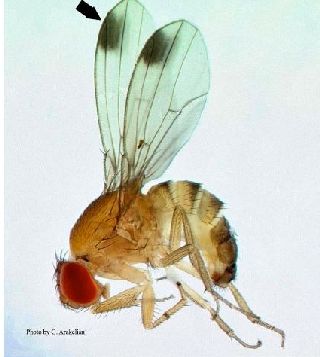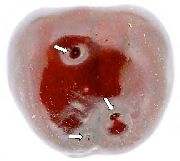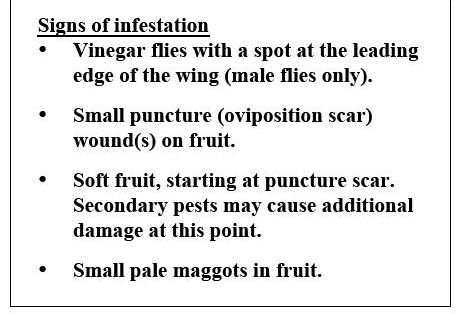
Publisher:
Bonnie King
CONTACT:
Newsroom@Salem-news.com
Advertising:
Adsales@Salem-news.com

~Truth~
~Justice~
~Peace~
TJP
Sep-17-2009 00:08

 TweetFollow @OregonNews
TweetFollow @OregonNews
Potential Fruit Fly Invasion Serious Threat for Oregon Fruit
Salem-News.comOfficials say the insects could shut down all of Oregon's fresh fruit sales.
 It is called the Drosophila Suzukii, yet this creature that appears to resemble a bee, is now being called a “Dragon Fruit Fly”. Photo: Oregon Dept. of Ag. |
(SALEM, Ore.) - The spotted wing Drosophila, which some have dubbed the “Dragon Fruit Fly”, has invaded Oregon from California and has already been confirmed in several Oregon fruit crops.
 Oviposition scars and larval |
Terry L. Witt, Executive Director of Oregonians for Food & Shelter, says the crops likely to be invaded include blueberries, caneberries and grapes.
Stuart Olson, a local peach, apple and cherry grower, believes this could literally shut down fresh fruit sales from Oregon.
"Unlike the vinegar fruit fly that takes to rotted fruit, this critter infects ripening fruit and is visible in the fruit as a small maggot."
Witt says talks are on, officials are very concerned about what this could mean for the state, and discussions are taking place between the Oregon Department of Agriculture and Oregon State University.
"We have discussed with ODA and they are stepping up discussions with OSU to learn more about the Dragon Fruit Fly and how we might deal with it in Oregon. ODA hopes to set up an informational meeting at the State Fairgrounds for next Tuesday."
They are hoping to see all fruit growers across the state informed and monitoring for this invader – and spreading the word.
Witt also says it will also be important to brief Legislators so they understand the potential seriousness of this pest and that they may be asked to provide emergency money for control.
The idea of using pesticides is also on the table.
Witt recognized that some anti-chemical advocates would likely be against the idea, but says, "they should understand that if the spotted wing Drosophila is becomes endemic, the industry that will be hit the hardest will be organic fruit growers."
Introduction
A news advisory sent out today by the ODA explains that the spotted wing Drosophila (SWD), Drosophila suzukii (Matsumura) (Diptera: Drosophilidae), is Asian (China, Japan, Korea, and Thailand) and is established in Hawaii and Spain.
SWD is a temperate species, and it may be able to survive in much of the US. It was detected in California during 2008 and Florida in 2009. Surveys conducted in Oregon after the California detections found SWD from Portland south into Douglas County.

This fly is of concern because unlike most members of its family, which only attack overripe or decaying fruit, it attacks ripe, healthy fruit. Fruits attacked include apple, blueberry, cane berries, cherry, grape, peach, persimmon, plum, and strawberry. Potential risk.
The damage to fruit is caused by the larvae (maggots) of SWD. Although small (less than 1/8 inch long), just one or two maggots can render fruit unmarketable. As many as 65 adults have been reported to emerge from a single cherry. It has been reported as a significant pest of cherries, blueberries, and grapes in Japan, blueberries in China, and raspberries, strawberries, and cherries in California.
Recently, infested blackberries, blueberries, and cherries were found in Oregon. Damage to cherries can be severe (another common name for SWD is the cherry vinegar fly), and infestations of up to 80 percent of the cherries in a locality have been reported. They have been found to attack tomatoes in the laboratory.
Because female SWD can lay many eggs and there can be many generations of SWD per year, populations could rapidly build to damaging levels.
Infested fruit has already been found at an Oregon “u-pick” site and in a market featuring local produce. Not just local sales of fruit could be affected. This fly’s presence in Oregon could lead to restrictions on shipping fresh fruit to the eastern US and possibly other uninfested countries.
Detection
Adults, larvae, and other life stages are similar to other vinegar flies. Adults are small, 2-3 mm long, with straw yellow bodies and red eyes. Males usually have a distinctive black spot on the outer edge of their wing. No other vinegar flies with a wing spot are commonly associated with fresh fruit and established in the US. Flies with wing spots should be submitted to the Oregon Department of Agriculture.
Females can only be identified by a trained entomologist. Eggs are difficult to detect in fruit. Oviposition scars are very small and may be mistaken for other types of damage, including the oviposition scars of other types of fruit flies. Larvae are small and difficult to detect inside the fruit, especially in early stages of attack or in low numbers.
No specific pheromone lures are available for use in detection. Adults will come to McPhail traps baited with a general fruit fly lure. Other trapping options may include apple maggot traps and traps baited with ammonium carbonate or fermented fruit mixtures.
Life cycle
Females oviposit in ripe fruit hanging on the tree. In cherries they typically lay a few eggs per fruit, although many more larvae per fruit is not uncommon. The oviposition scar is simply a small puncture in the skin of the fruit, although larval feeding damage can quickly cause the surrounding area to collapse forming a soft indentation.
Populations in Japan have up to fifteen generations per year from April to November. The adults overwinter. A female SWD can lay 7 to 13 eggs per day, averaging about 384 eggs over her lifetime.
References
Cline, H. 2009. New name for a cherry pest. Western Farm Press. accessed September 2, 2009 at: westernfarmpress.com/news_archive/cherry-pest-0824/
Kanzawa, T. 1936. Studies on Drosophila suzukii Mats. Journal of Plant Protection (Tokyo) 23: 66-70. 127-132, 183-191. Abstract in Review of Applied Entomology 24: 315.
Kanzawa, T. 1939. Studies on Drosophila suzukii Mats. Kofu, Yamanashi Agric. Exp. Sta. 49 pp. Abstract in Review of Applied Entomology 29: 622.
Pozzi, J. 2009. Detection advisory: Cherry vinegar fly. California Department of Food and Agriculture. 2 p.
Steck, G.J., W. Dixon, and D. Dean. 2009. Pest Alert: Spotted Wing Drosophila, Drosophila suzukii (Matsumura) (Diptera: Drosophilidae), a fruit pest new to North America. Florida Div. of Ag. and Consumer Services. Accessed Aug. 1, 2009 at: www.doacs.state.fl.us/pi/enpp/ento/drosophila_suzukii.html
Articles for September 16, 2009 | Articles for September 17, 2009 | Articles for September 18, 2009

googlec507860f6901db00.html
Salem-News.com:



Terms of Service | Privacy Policy
All comments and messages are approved by people and self promotional links or unacceptable comments are denied.
Freddie August 9, 2010 12:12 am (Pacific time)
I had a farm growing raspberries in China. It was totally desimated by this fruit fly. I would urge you to be vigilant as it not so easy to control!
Mark Bolda September 17, 2009 4:17 pm (Pacific time)
Readers might be informed that this pest is not as serious as the article implies. Yes it is new and does cause damage, but its management is fairly straightforward once growers they have detected this pest in their crops. Furthermore, the article is misleading when it implies there could be restrictions on shipping produce out of the state. As of now, there have been no indications from the USDA that quarantines will be put into effect anywhere. People who are interested in further information on D. suzukii should refer to the following website: http://ucanr.org/blogs/strawberries_caneberries/
[Return to Top]©2025 Salem-News.com. All opinions expressed in this article are those of the author and do not necessarily reflect those of Salem-News.com.